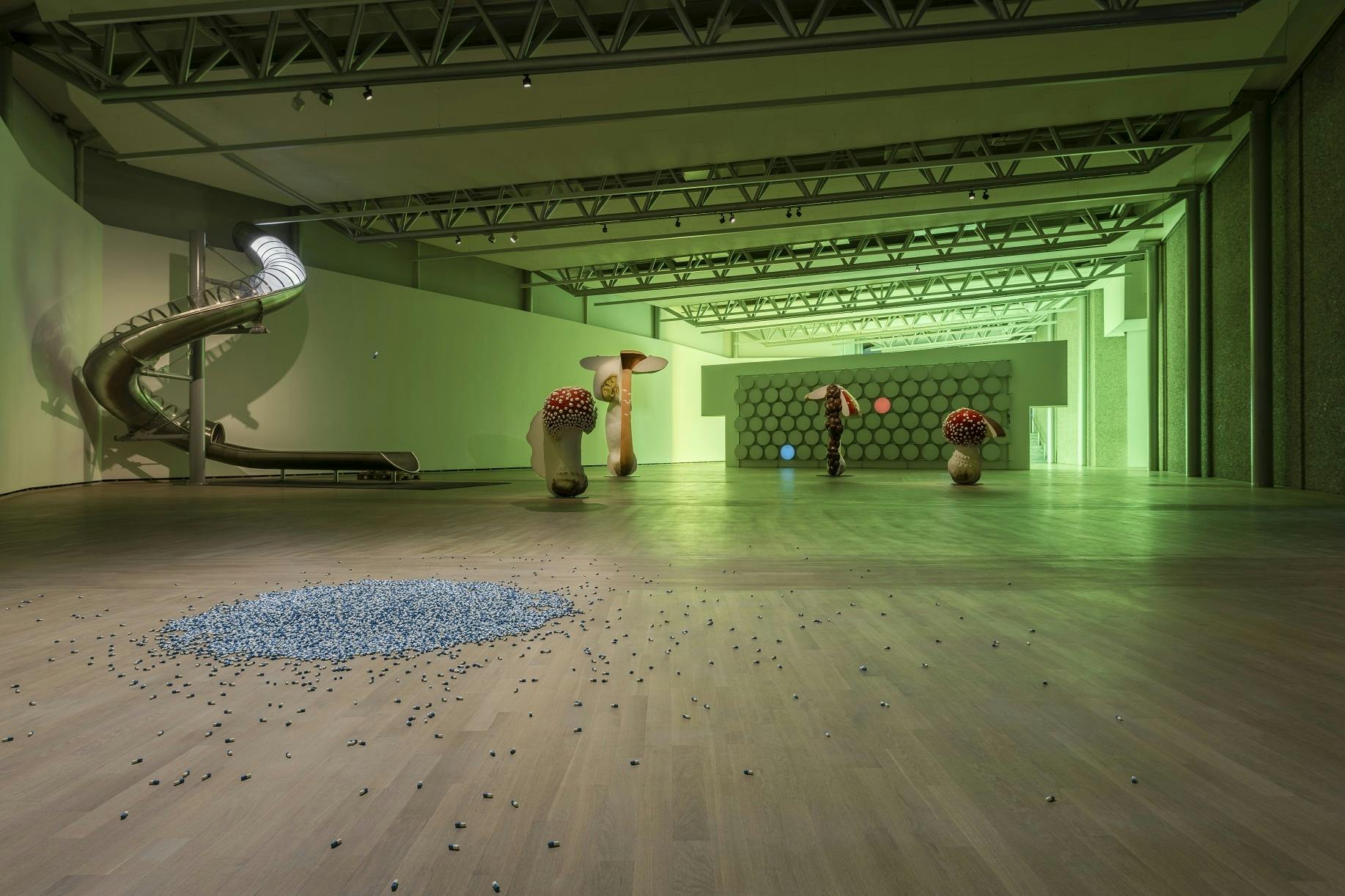Carsten Höller
Henie Onstad Sanatorium

Installation shot: Attilio Maranzano
For the summer’s major exhibition event, the Henie Onstad Kunstsenter will change its name to Henie Onstad Sanatorium, while characteristic installations will transform the building’s architecture.
To support the central idea behind Höller's exhibition, the Henie Onstad Kunstsenter will change its name to Henie Onstad Sanatorium during the exhibition period. In addition to the temporary name change, the building’s architecture will also be reworked through a series of experimental installations, presenting visitors with a unique set of experiences.
A slide curves from the outside and into the building, while distinctive sculptures invite you to float, move through complete darkness, and fly. The exhibition also includes two robotically-engineered beds, which offer visitors a unique opportunity to spend the night in the exhibition itself.
Re-experience the sanatorium
In the late 1800s and early 1900s there were several sanatoriums in the vicinity of Høvikodden. Built to cure various diseases, sanatoriums were often situated in beautiful scenery, close to the forest and the sea, where the air was healthy. While some were designed to cure tuberculosis, other, older sanatoriums were intended to provide recreation and relaxation, more in line with what we might associate today with a spa visit.
Along the lines of these ideas, and based on the Henie Onstad's unique location, Höller got the idea for the exhibition's title and concept the first time he visited Høvikodden.
Carsten Höller is inspired by research and experiments from the history of science, and uses these techniques to create tools, architecture and installations, aiming to present audiences with unique physical and psychological experiences.
Höller's art can be seen as a set of proposals for radically different ways of living and of being in the world, as expressed in his characteristic architectural alterations, moving beds, walls of flashing lights, or his famous slide installations.
- Carsten Höller ─ Henie Onstad Sanatorium
-
Carsten Höller
-
Caroline Ugelstad
-
Carsten Höller uses his training as a scientist in his work as an artist, concentrating particularly on the nature of human relationships.
Born in Brussels in 1961, he now lives and works in Stockholm, Sweden and Biriwa, Ghana. His major installations include Test Site, a series of giant slides for Tate Modern’s Turbine Hall (2006), Amusement Park - an installation of full-size funfair rides turning and moving at very slow speed at MASS MoCA, North Adams, USA (2006), Flying Machine (1996), a work which hoists the viewer through the air, Upside-Down Goggles, an experiment with goggles which modify vision, and the famous The Double Club (2008-2009) in London, which opened in November 2008 and closed in July 2009, took the form of a bar, restaurant and nightclub designed to create a dialogue between Congolese and Western culture.
His Revolving Hotel Room, 2008, a rotating art installation that becomes a fully operational hotel room at night, was shown as part of theanyspacewhatever exhibition at the Guggenheim Museum in 2009. For his 2015 exhibition Decision at the Hayward Gallery, he turned the whole building into an experimental parcours with two entrances and four exits, two of them slides.
His works have been shown internationally over the last two decades, including solo exhibitions at Fondazione Prada, Milan (2000), the ICA Boston (2003), Musée d'Art Contemporain, Marseille (2004), Kunsthaus Bregenz, Austria (2008), Museum Boijmans Van Beuningen, Rotterdam (2010), Hamburger Bahnhof, Museum für Gegenwart, Berlin (2011), New Museum, New York (2011) Thyssen-Bornemisza Art Contemporary (TBA21), Vienna (2014), and most recently Doubt at Pirelli HangarBicocca, Milan (2016).
Installation shots
-
![Holler 03 Attilio Maranzano]()
Installation shot: Attilio Maranzano
-
![Holler 05 Attilio Maranzano]()
↑ Flying Machines Installation shot: Attilio Maranzano
-
![Holler 04 Attilio Maranzano]()
Installation shot: Attilio Maranzano
-
![Holler 08 Attilio Maranzano]()
Installation shot: Attilio Maranzano
-
![Holler Henie Onstad Sanatorium 2017 Foto Attilio Maranzano]()
Installation shot: Attilio Maranzano
-
![Holler 15 Foto Attilio Maranzano]()
Installation shot: Attilio Maranzano
-
![Holler 13 Foto Attilio Maranzano]()
Installation shot: Attilio Maranzano
-
![Holler 22 Foto Attilio Maranzano]()
↑ Two Roaming Beds Installation shot: Attilio Maranzano
-
![Holler 31 Foto Attilio Maranzano]()
Installation shot: Attilio Maranzano
-
![Holler 29 Foto Attilio Maranzano]()
Installation shot: Attilio Maranzano
-
![Holler 26 Foto Attilio Maranzano]()
Installation shot: Attilio Maranzano
-
![Holler 35 Foto Attilio Maranzano]()
Installation shot: Attilio Maranzano





































